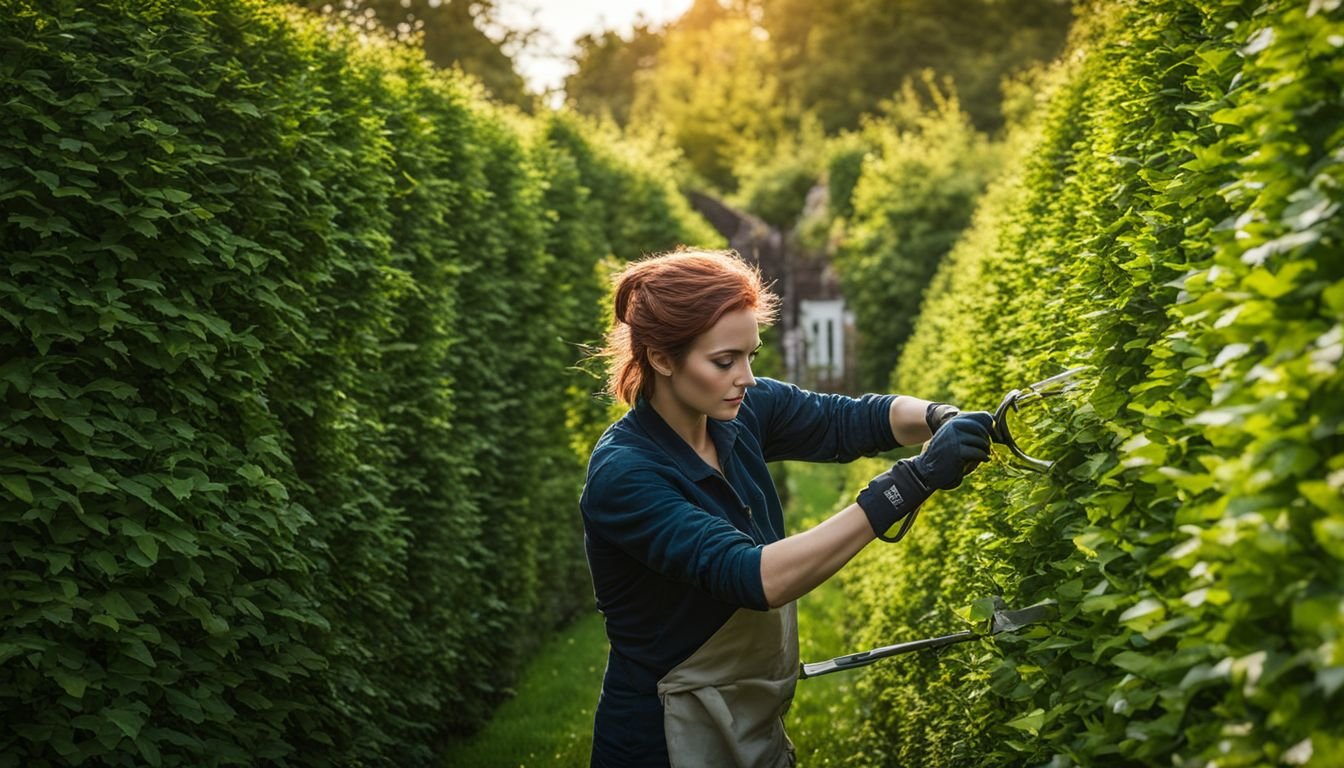Growing a lush, green hedge in Australia can sometimes feel like you’re trying to solve a rather tricky puzzle. You’re probably keen for something that not only looks stunning but also adds a bit of practicality to your patch, yet finding the right fit might have you scratching your head.
The Hornbeam, or Carpinus betulus for those who fancy the technical name, often flies under the radar here in Aussie gardens. But believe us when we say it’s a top-notch choice for our unique climate.
Selecting the perfect plant for your garden can be a bit of a journey – and yep, we’ve walked that path ourselves! After delving into the world of hedges, it turns out the European hornbeam really is something special.
And why’s that? This robust tree keeps its vibrant green leaves nearly all year round, providing privacy even during winter because it clings onto last year’s foliage well into the cooler months.
Pretty clever, right? Our guide will take you step by step through planting your very own hornbeam hedge – from choosing just the right spot in your backyard to making sure it thrives.
We’ve also thrown in some advice on how to tackle those common niggles head-on.
Prepare to give your garden space an incredible makeover!
Key Takeaways
- Plant your hornbeam hedge in a spot where it can enjoy partial sunlight and has room for roots to spread, ensuring it doesn’t dry out during Australia’s hot summers.
- Prepare the soil with special fertiliser containing mycorrhizal fungi to boost nutrient absorption and improve survival rates of your hedge after planting.
- Regularly prune your hornbeam from late summer through mid – winter to maintain its shape, enhance density, and ensure healthy growth by allowing better airflow.
- Keep the soil around your hornbeam moist, especially during dry spells, by watering deeply once a week and more frequently during very hot weather.
- Tackle common challenges like drying out or fungal diseases promptly by maintaining good watering practices and ensuring proper air circulation around plants.
Steps to Plant a Hornbeam Hedge

We all can agree that setting up a Hornbeam hedge adds beauty to our gardens. First up, we need to find the perfect spot where it can soak up enough sunlight and has room for its roots to spread out.
Then, it’s time to get our hands dirty prepping the earth, making sure it’s rich and well-drained for our new leafy friends. Grab your gardening tools; let’s make some magic happen in our Aussie backyards!
Choosing the right location
Finding the perfect spot for your hornbeam hedge means considering how much shade and sunlight the area gets. Hornbeams love heavy shade but still need some access to light to thrive.
We watch our gardens closely, aiming to pick a spot that balances both needs. This makes sure our hedges grow healthy and strong.
We also think about if we want our outdoor spaces wrapped in evergreen or adorned with the changing colors of deciduous trees like the common hornbeam. This choice affects not just how our garden looks across seasons but also budgeting for care and maintenance.
Before planting, we check that the chosen location keeps away from places too exposed to harsh sunlight, especially during Australia’s hot summers. European hornbeams don’t like drying out when it gets hot; so making sure they have a bit of shelter from direct sun helps keep them happy and hydrated.
These careful steps ensure we give our hedges the best start in their new home.
Preparing the soil
Preparing the soil plays a crucial role in ensuring your hornbeam hedge thrives. First, we need to dig a trench for the bare-root cuttings. This ensures that our young plants will have enough room to stretch their roots out.
Make sure the trench is both wide and deep enough to accommodate the root systems comfortably.
Next, we add a specialised fertiliser containing mycorrhizal fungi to the soil. This magical ingredient helps our hornbeam hedges absorb nutrients more efficiently and improves their survival rate after transplanting.
It’s like giving your garden plant a health boost from day one!
“Healthy soil equals healthy plants.”
Once you’ve prepared the bed with nutrients and care, it’s time to move on to planting your hedge.
Planting the hedge
We carefully pick a spot that the sun shines on and where the soil drains well. European hornbeam loves these conditions. We dig holes larger than the root balls of our saplings to give them plenty of room to spread out and take hold.
Each young tree is placed in its own hole, ensuring they’re spaced correctly for a dense, attractive screen.
We cover the roots with soil and water deeply to settle them into their new home. This encourages strong growth right from the start. Next, we move on to how we maintain our hornbeam hedge to keep it looking its best year-round.
Maintaining a Hornbeam Hedge

Keeping a hornbeam fence in top shape needs regular care. We often grab our shears to trim the branches, encouraging them to grow thick and lush. This way, our hedge not only looks neat but also provides a solid screen for privacy.
Alongside clipping, giving the plants enough water and nutrients ensures they stay healthy and vibrant through the seasons.
Regular pruning
Pruning your European Hornbeam hedge keeps it from getting too wild and messy. We cut back the branches regularly to shape the plant and enhance its density. This task is best done from late summer through mid-winter.
Pruning at this time minimises sap loss, which can stress the plants. Each snip helps our hedge remain thick, letting it grow in a well-defined way that pleases the eye.
Our goal includes promoting robust health and encouraging fresh leaves to sprout. Trimming wisely means we also boost air flow and sunlight reaching every part of the shrub, making for a more vibrant barrier against prying eyes or strong winds.
During pruning, removing sick or dead wood ensures our green friends stay in top condition.
Next up, we’ll explore how watering and fertilising play their roles in nurturing our hornbeam hedges.
“A well-pruned hedge is a happy hedge.”
Watering and fertilising
We all agree, keeping our hornbeam hedges lush and healthy means sticking to a proper watering schedule. These plants crave a good drink every week, especially during those scorching Australian summers when the mercury soars.
If you find your garden under the fierce sun more often than not, consider giving your hedge an extra dose of water. This helps them stay hydrated and grow strong.
Fertilising isn’t something we should skip either. For our hornbeam friends to thrive, using fertiliser that’s rich in mycorrhizal fungi is smart. This special ingredient does wonders by helping roots take better hold after planting and improves how well they pick up nutrients from the soil around them.
It acts like a superfood for your plants, making sure they have all they need to flourish throughout the year without worrying over nutrient shortages.
To sum it up, giving our hornbeam hedges enough water and feeding them right ensures they remain stunning features in our gardens. They don’t just make for beautiful green screens or natural fences but also create refreshing spots of shade on hot days, turning our outdoor spaces into tranquil havens where we can unwind or play.
Overcoming Common Hornbeam Hedge Challenges
Facing problems with your Hornbeam hedge can seem tough, but tackling them head-on makes your gardening journey rewarding. One common issue is the hedge drying out in Australia’s hot weather.
To prevent this, ensure you’re keeping the soil moist. Water deeply and regularly during dry spells. This will stop the leaves from wilting and keep your hedge looking vibrant.
Another challenge is ensuring rapid growth and dense coverage for privacy or as a barrier. For this, enriching your planting ground plays a crucial role. Mix plenty of organic matter into the soil before planting and apply mulch around the base to retain moisture.
Pleaching or training young trees along frames can also help form a thick, uniform barrier faster than letting them grow unaided.
Fungal diseases might scare some gardeners since they can affect hornbeams too. Keep an eye out for any unusual signs on leaves or branches – early detection means easier management! Prune away affected parts promptly to prevent spread, and ensure good air circulation by not crowding plants closely together.
Now that we’ve covered overcoming these hurdles let’s move on to how you can continue enjoying your Hornbeam hedge in Australia.
Conclusion: Enjoying Your Hornbeam Hedge in Australia
Planting and looking after a hornbeam fence in your Aussie garden brings a touch of elegance and privacy. You’ve chosen the perfect spot, prepared the soil well, and created something beautiful.
Keep up with trimming, giving enough water, and adding nutrients to see it thrive. Over time, this hedge will grow strong barriers against noise without much trouble from pests or diseases.
Enjoy your lush green space that adds character to your home all year round.
FAQs
1. What types of trees can I use for a hedge in Australia?
In Australia, you can use various trees for hedges, such as the ornamental Hornbeam, English Yew, European Beech including its varieties like Copper Beech and Purple Beech, and even Conifers.
2. How do I plant a Hornbeam hedge?
To plant a Hornbeam hedge, choose a suitable location with good soil. Dig holes that are big enough for the roots to spread out. Place your shrubs in the holes and fill them back up with soil. Make sure you water them well after planting.
3. Can I make my Hornbeam hedge into shapes or designs?
Yes! Once your Hornbeam hedge has grown tall enough, you can trim it into different shapes or designs. This practice is known as topiary and it’s a fun way to add character to your garden.
4. How do I maintain my Hedge healthy?
Maintaining your Hedge involves regular watering especially during dry spells trimming it to shape if desired and checking occasionally for pests or diseases Keep an eye on its growth through seasons like when yellow catkins appear on hornbeams indicating springtime health.
